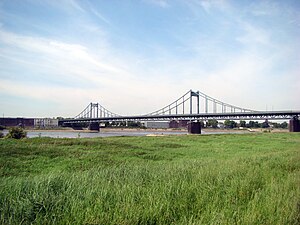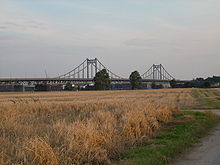Krefeld-Uerdinger Bridge
Coordinates: 51 ° 20 ′ 59 " N , 6 ° 39 ′ 34" E
|
|
||
|---|---|---|
| Krefeld-Uerdinger Rhine Bridge | ||
| Official name | Rhine bridge Krefeld-Uerdingen | |
| Convicted | Bundesstrasse 288 | |
| Crossing of | Rhine | |
| place | Uerdingen / Duisburg | |
| construction | Rein belt bridge | |
| overall length | 860 m | |
| width | 19.5 m | |
| Longest span | 250 m | |
| Construction height | 7.25 m | |
| building-costs | 6.3 million RM (today's purchasing power approx. 27.4 million EUR) |
|
| start of building | 1933 | |
| completion | 1936 | |
| location | ||
|
|
||
The Uerdinger Rhein bridge spanning between the Krefeld district Uerdingen and the Duisburger district Mündelheim as Zügelgurtbrücke the Rhine . The structure is 860 m long and has two lanes and two sidewalks. It is one of the last "fake" suspension bridges over the Rhine. The Uerdinger Rheinbrücke is part of the federal highway 288 . The building is one of the most beautiful bridges over the Rhine and has been a listed building since 1987 because of the “architectural conception of the desired harmony between nature and technology”.
history
In 1933 construction of the Rhine bridge began based on a design by Friedrich Voss . During the foundation work of the pillars, a 27 million year old fossilized primeval whale skull was found, which can be seen today in the Essen Ruhr Museum and is considered an important find (Patriocetus). On June 7, 1936, the inauguration with the name "Adolf Hitler Bridge" by Rudolf Hess followed . The construction replaced the old ferry connection between Mündelheim and Uerdingen. The construction costs amounted to 6.3 million Reichsmarks, which today corresponds to around 27.4 million euros. On March 4, 1945, Wehrmacht troops blew up the river bridge when Allied troops advanced to the Rhine as part of Operation Grenade . In the run-up to this, there were very tough battles over the bridge, in the course of which the old town of Uerdingen was particularly affected.
At the end of 1948, the reconstruction began largely using old construction parts according to the original construction drawings.
On November 4, 1950, the Rhine Bridge was reopened as the "Krefeld-Uerdinger Bridge" by Prime Minister Karl Arnold . Reinforcement measures were taken in 1964 to increase the load-bearing capacity; Between 1984 and 1993 it was repaired for ten million DM (according to today's purchasing power around 7.5 million euros).
Together with the Bridge of Solidarity , the Krefeld-Uerdinger Bridge is part of the Route of Industrial Culture : Themed Route Industrial Culture on the Rhine .
construction
Approach bridges
The foreland bridge on the left bank of the Rhine is an 88 m long three-span solid wall girder construction made of steel with pendulum supports made of steel as pillars. The foreland bridge on the Mündelheim side is a 270 m long truss bridge with six fields and an overhead carriageway.
Power bridge
The three-span main bridge has a total length of 500 m spans of 125.0 m + 250.0 m + 125.0 m and is 19.5 m wide. The building system is a cantilever bridge in the longitudinal direction with a 50 m long suspension beam , which is arranged in the middle of the flow opening. Since the “suspension cables” consist of profile girders that are connected to one another in a polygonal manner by rivets and transfer their tensile forces into the superstructure, the construction is also known as a false bridle strap. The longitudinal girders, arranged between the carriageway, are 7.25 m high lattice girders, which are connected to each other by cross girders every 6.25 m and are suspended from seven posts every 12.5 m from the pylon. The 40 m high pylons are 1.25 m wide. Since it was repaired in the 1980s, the slab in the stream opening has been a 20 cm thick reinforced concrete composite slab ; originally they were prefabricated hollow panels that had no connection with the steel structure. In the side openings there are 30 cm thick cast-in-place concrete slabs. The pillars were founded with caissons ; they are made of stamped concrete and are clad with basalt lava.
Expansion planning
In the Federal Transport Infrastructure Plan 2030 , the continuous four-lane expansion of the B 288, and thus also the Rhine crossing, is classified as a “further need with planning rights” and is therefore not expected until 2030 at the earliest. A demolition of the listed bridge cannot therefore be ruled out.
literature
- Reinhard Ruhrberg: Damage to bridges and other engineering structures. Causes and Findings. Documentation. Verkehrblatt-Verlag Borgmann, Dortmund 1994, ISBN 3-89273-069-5 .
Web links
- Uerdinger Bridge at brueckenweb.de with historical photos
- “… Nur os Oedingsch aan” - completion of the Rhine bridge 70 years ago
- Description of this sight on the route of industrial culture
- Entry on Rhine bridge Uerdingen - Mündelheim (cultural landscape area Regionalplan Ruhr 078) in the database " KuLaDig " of the Rhineland Regional Association
- Bridge photo from the 1930s (digit.wdr.de)
- Photo of the floating gantry crane used to rebuild the bridge in 1946
Individual evidence
- ↑ Rainer Bartel: Rheinbrücken (6): The Krefeld-Uerdinger-Rheinbrücke - perhaps the most beautiful of its kind. Rhein-Magazin Düsseldorf, March 15, 2018, accessed on May 25, 2018 .
- ↑ US War Report, pp. 173–178.
- ^ Reinhard Ruhrberg: Damage to bridges and other engineering structures. Causes and Findings. Documentation. Verkehrblatt-Verlag Borgmann, Dortmund 1994, ISBN 3-89273-069-5 , p. 242.
- ^ A 524 OD Krefeld - Duisburg-Serm. In: Project Information System (PRINS) on the Federal Transport Infrastructure Plan 2030. Federal Ministry of Transport and Digital Infrastructure, accessed on May 25, 2018 .
- ↑ Jonas Schlömer: A524 will be expanded in Duisburg "in 2030 at the earliest". derwesten.de, April 4, 2016, accessed on May 25, 2018 .
- ↑ Norbert Stirken: Rhine bridge: Memorial demolition not taboo. RP Online, January 18, 2014, accessed May 25, 2018 .
|
The next bridge upstream: the airport bridge |
Bridges over the Rhine |
The next bridge down the river: Duisburg-Hochfelder railway bridge |






